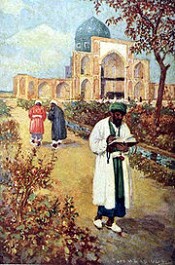Omar Khayyám

Omar Khayyám (Persian: عمر خیام), (born 1048 AD, Neyshapur, Iran—1131 AD, Neyshapur, Iran), was a Persian polymath,[2] mathematician, philosopher, astronomer, physician, and poet. He also wrote treatises on mechanics, geography, and music.[3] He has also become established as one of the major mathematicians and astronomers of the medieval period. Recognized as the author of the most important treatise on algebra before modern times as reflected in his Treatise on Demonstration of Problems of Algebra giving a geometric method for solving cubic equations by intersecting a hyperbola with a circle.[4] He also contributed to thecalendar reform and may have proposed a heliocentric theory well before Copernicus. His significance as a philosopher and teacher, and his few remaining philosophical works, have not received the same attention as his scientific and poetic writings. Zamakhshari referred to him as “the philosopher of the world”. Many sources have also testified that he taught for decades the philosophy of Ibn Sina in Nishapur where Khayyám lived most of his life, breathed his last, and was buried and where his mausoleum remains today a masterpiece of Iranian architecture visited by many people every year.[5] Outside Iran and Persian speaking countries, Khayyám has had impact on literature and societies through translation and works of scholars. The greatest such impact was in English-speaking countries; the English scholar Thomas Hyde (1636–1703) was the first non-Persian to study him. However the most influential of all was Edward FitzGerald (1809–83)[6] who made Khayyám the most famous poet of the East in the West through his celebrated translation and adaptations of Khayyám's rather small number of quatrains (rubaiyaas) in Rubáiyát of Omar Khayyám. Khayyám's full name was Ghiyath al-Din Abu'l-Fath Umar ibn Ibrahim Al-Nishapuri al-Khayyami(Persian: غیاث الدین ابو الفتح عمر بن ابراهیم خیام نیشاپوری) and was born in Nishapur, Iran, then a Seljuk capital in Khorasan (present Northeast Iran), rivaling Cairo or Baghdad. He is thought to have been born into a family of tent makers (literally, al-khayyami in Arabic means "tent-maker"); later in life he would make this into a play on words: He spent part of his childhood in the town of Balkh (present northern Afghanistan), studying under the well-known scholar Sheik Muhammad Mansuri. Subsequently, he studied under Imam Mowaffaq Nishapuri, who was considered one of the greatest teachers of the Khorassan region. Omar Khayyám was famous during his times as a mathematician. He wrote the influential Treatise on Demonstration of Problems of Algebra (1070), which laid down the principles of algebra, part of the body of Persian Mathematics that was eventually transmitted to Europe. In particular, he derived general methods for solving cubic equations and even some higher orders. In the Treatise he also wrote on the triangular array of binomial coefficients known as Pascal's triangle. In 1077, Omar wrote Sharh ma ashkala min musadarat kitab Uqlidis (Explanations of the Difficulties in the Postulates of Euclid). An important part of the book is concerned with Euclid's famous parallel postulate, which had also attracted the interest of Thabit ibn Qurra. Al-Haytham had previously attempted a demonstration of the postulate; Omar's attempt was a distinct advance, and his criticisms made their way to Europe, and may have contributed to the eventual development of non-Euclidean geometry. Omar Khayyám also had other notable work in geometry, specifically on the theory of proportions. Khayyám wrote a book entitled Explanations of the difficulties in the postulates in Euclid's Elements. The book consists of several sections on the parallel postulate (Book I), on the Euclidean definition of ratios and the Anthyphairetic ratio (modern continued fractions) (Book II), and on the multiplication of ratios (Book III). The first section is a treatise containing some propositions and lemmas concerning the parallel postulate. It has reached us from a reproduction in a manuscript written in 1387-88 AD by the Persian mathematician Tusi. Tusi mentions explicitly that he re-writes the treatise "in Khayyám's own words" and quotes Khayyám, saying that "they are worth adding to Euclid's Elements (first book) after Proposition 28."[7] This proposition [8] states a condition enough for having two lines in plane parallel to one another. After this proposition follows another, numbered 29, which is converse to the previous one.[9] The proof of Euclid uses the so-called parallel postulate (numbered 5). Objection to the use of parallel postulate and alternative view of proposition 29 have been a major problem in foundation of what is now called non-Euclidean geometry. The treatise of Khayyám can be considered as the first treatment of parallels axiom which is not based on petitio principii but on more intuitive postulate. Khayyám refutes the previous attempts by other Greek and Persian mathematicians to prove the proposition. And he, as Aristotle, refuses the use of motion in geometry and therefore dismisses the different attempt by Ibn Haytham too.[10] In a sense he made the first attempt at formulating a non-Euclidean postulate as an alternative to the parallel postulate,[11] This philosophical view of mathematics (see below) has had a significant impact on Khayyám's celebrated approach and method in geometric algebra and in particular in solving cubic equations. In that his solution is not a direct path to a numerical solution and in fact his solutions are not numbers but rather line segments. In this regard Khayyám's work can be considered the first systematic study and the first exact method of solving cubic equations.[13] In an untitled writing on cubic equations by Khayyám discovered in 20th century[12], where the above quote appears, Khayyám works on problems of geometric algebra. First is the problem of "finding a point on a quadrant of a circle such that when a normal is dropped from the point to one of the bounding radii, the ratio of the normal's length to that of the radius equals the ratio of the segments determined by the foot of the normal." Again in solving this problem, he reduces it to another geometric problem: "find a right triangle having the property that the hypotenuse equals the sum of one leg (i.e. side) plus the altitude on the hypotenuse.[14] To solve this geometric problem, he specializes a parameter and reaches the cubic equation x3 + 200x = 20x2 + 2000.[12] Indeed, he finds a positive root for this equation by intersecting a hyperbola with a circle. This particular geometric solution of cubic equations has been further investigated and extended to degree four equations.[15] Regarding more general equations he states that the solution of cubic equations requires the use of conic sections and that it cannot be solved by ruler and compass methods.[12] A proof of this impossibility was plausible only 750 years after Khayyám died. In this paper Khayyám mentions his will to prepare a paper giving full solution to cubic equations: "If the opportunity arises and I can succeed, I shall give all these fourteen forms with all their branches and cases, and how to distinguish whatever is possible or impossible so that a paper, containing elements which are greatly useful in this art will be prepared."[12] This refers to the book Treatise on Demonstrations of Problems of Algebra (1070), which laid down the principles of algebra, part of the body of Persian Mathematics that was eventually transmitted to Europe.[13] In particular, he derived general methods for solving cubic equations and even some higher orders. This particular remark of Khayyám and certain propositions found in his Algebra book has made some historians of mathematics believe that Khayyám had indeed a binomial theorem up to any power. The case of power 2 is explicitly stated in Euclid's elements and the case of at most power 3 had been established by Indian mathematicians. Omar was the mathematician who noticed the importance of a general binomial theorem. The argument supporting the claim that Omar had a general binomial theorem is based on his ability to extract roots.[17] The Khayyam–Saccheri quadrilateral was first considered by Omar Khayyám in the late 11th century in Book I of Explanations of the Difficulties in the Postulates of Euclid.[18] Unlike many commentators on Euclid before and after him (including of course Saccheri), Khayyám was not trying to prove the parallel postulate as such but to derive it from an equivalent postulate he formulated from "the principles of the Philosopher" (Aristotle): Khayyám then considered the three cases (right, obtuse, and acute) that the summit angles of a Saccheri quadrilateral can take and after proving a number of theorems about them, he (correctly) refuted the obtuse and acute cases based on his postulate and hence derived the classic postulate of Euclid. It wasn't until 600 years later that Giordano Vitale made an advance on Khayyám in his book Euclide restituo (1680, 1686), when he used the quadrilateral to prove that if three points are equidistant on the base AB and the summit CD, then AB and CD are everywhere equidistant. Saccheri himself based the whole of his long, heroic, and ultimately flawed proof of the parallel postulate around the quadrilateral and its three cases, proving many theorems about its properties along the way. Like most Persian mathematicians of the period, Omar Khayyám was also famous as an astronomer. In 1073, the Seljuk Sultan Sultan Jalal al-Din Malekshah Saljuqi (Malik-Shah I, 1072-92), invited Khayyám to build an observatory, along with various other distinguished scientists. One being Shamse Tabrizi, his mentor and the father of Kimia Khatoon,who he fell in love with. Eventually, Khayyám and his colleagues measured the length of the solar year as 365.2425 days. Omar's calendar was more accurate than 500 years later the Gregorian calendar. The modern Iranian calendar is based on his calculations Omar Khayyám was part of a panel that introduced several reforms to the Persian calendar, largely based on ideas from the Hindu calendar. On March 15, 1079, Sultan Malik Shah I accepted this corrected calendar as the official Persian calendar.[20]
do you like this author?
What readers are saying
What do you think? Write your own comment on this book!
write a commentWhat readers are saying
What do you think? Write your own comment on this author!
write a commentBook list

The Stanzas of Omar Khayyam
Series:
Unknown
Year:
Unknown
Raiting:
4.5/5
Book digitized by Google from the library of the University of Michigan and uploaded to the Internet Archive by user tpb.
Show more
add to favoritesadd In favorites

Rubyt Umar al-Khayym
Series:
Unknown
Year:
Unknown
Raiting:
3.5/5
Parallel texts in Arabic and Persian on opposite pages and with separate paging 26
Show more
add to favoritesadd In favorites

Rubáiyát of Omar Khayyám, the astronomer poet of Persia. Rendered into English verse
Series:
Unknown
Year:
Unknown
Raiting:
3/5
26
Show more
add to favoritesadd In favorites

Strophes
Series:
Unknown
Year:
Unknown
Raiting:
4/5
Errata slip tipped in The 2d ed. published under the title: Stanzas 26
Show more
add to favoritesadd In favorites

Stanzas
Series:
Unknown
Year:
Unknown
Raiting:
3.5/5
The 1st ed. published under the title: Strophes 26
Show more
add to favoritesadd In favorites

Les quatrains de Khèyam
Series:
Unknown
Year:
Unknown
Raiting:
4/5
French and Persian on opposite pages 26
Show more
add to favoritesadd In favorites
What readers are saying
What do you think? Write your own comment on this author!
write a commentif you like Omar Khayyám try:
readers also enjoyed
What readers are saying
What do you think? Write your own comment on this author!
write a commentGenre
if you like Omar Khayyám try:
readers also enjoyed
Do you want to read a book that interests you? It’s EASY!
Create an account and send a request for reading to other users on the Webpage of the book!


